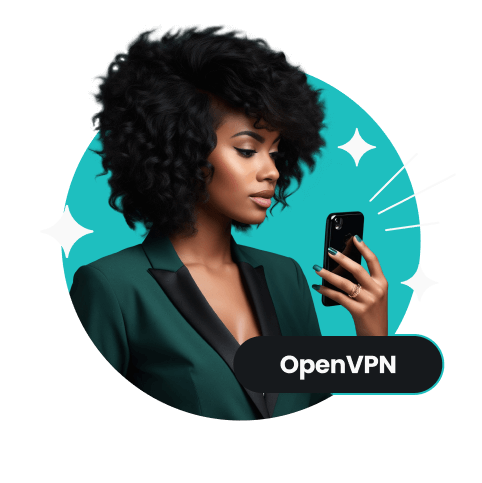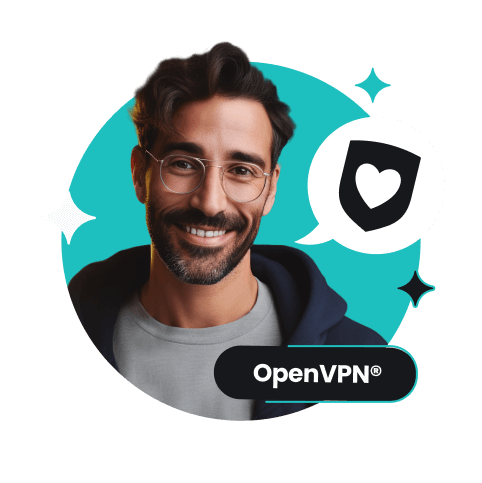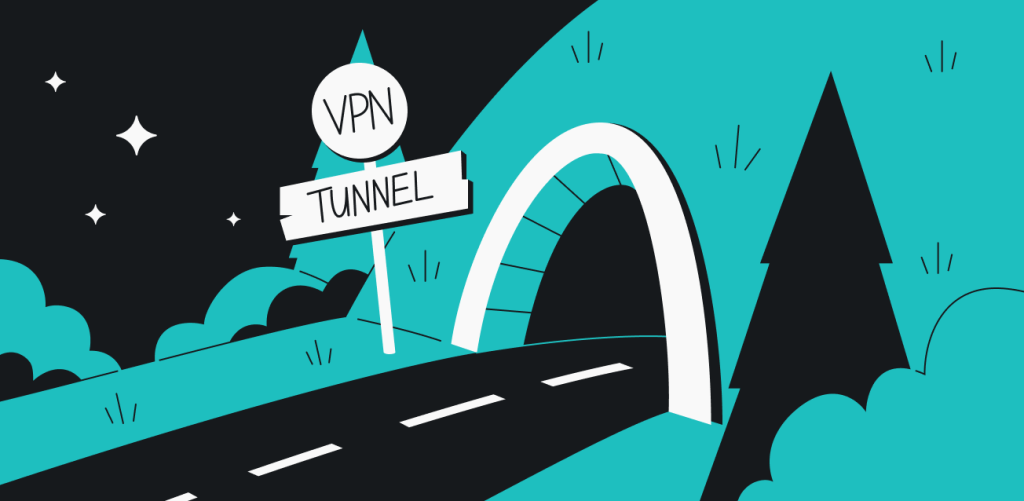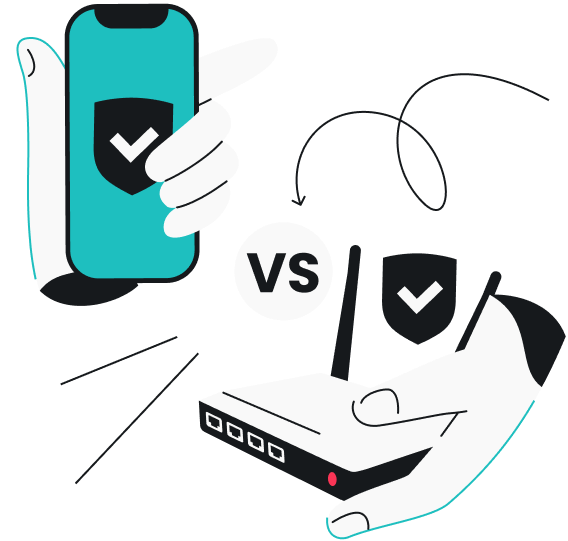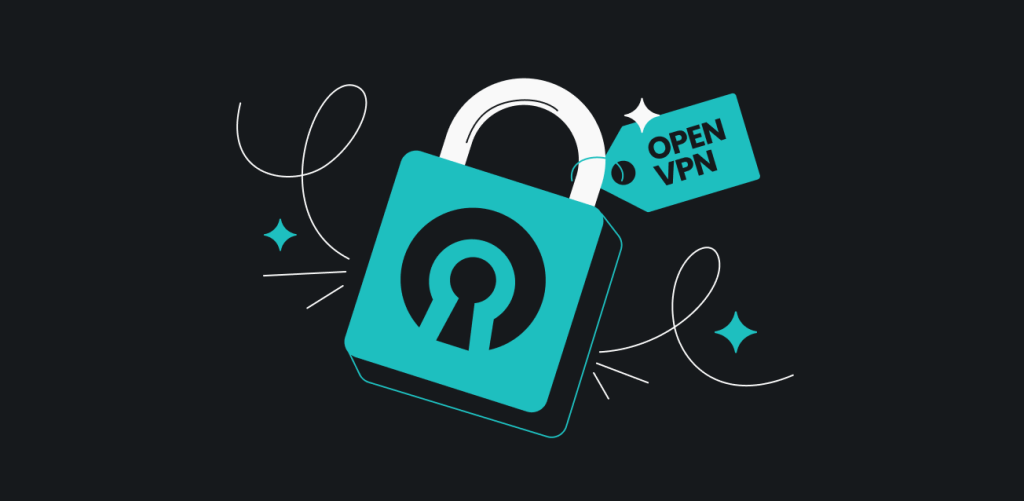
Your internet connection is important and deserves that VIP treatment.
Using OpenVPN is a great place to start. As a VPN (Virtual Private Network) protocol, OpenVPN is a popular choice for setting up a secure VPN tunnel and protecting your online activity.
What is OpenVPN, and how does it actually work? Here’s everything you need to know, explained in plain English.
Table of contents
What is OpenVPN?
OpenVPN is a VPN protocol that helps create safe and sturdy virtual private network connections. Today’s top VPN services — like Surfshark — use OpenVPN to build secure tunnels within their private networks.
Now, what is a VPN protocol?
A VPN protocol is a set of rules determining how your device connects to a VPN. Think of it as a language these tools use to communicate with one another while your data travels securely across the web. Popular alternatives include WireGuard and IKEv2.
What makes OpenVPN so special?
OpenVPN was created in 2001 using open-source code that allowed anyone to check its performance. It’s been thoroughly tested over the years, so it’s now an established option widely regarded as safe and reliable.
For everyday users, OpenVPN is one of the most popular — and most secure — VPN protocols available. If you’re looking for enhanced privacy as you surf the web, OpenVPN offers secure connections without compromising fast speeds.
Note: OpenVPN can refer to two more things. First, it’s the name given to the open-source software behind the protocol that tech-savvy users can use to craft their own VPN clients. Second, the term also refers to the OpenVPN company, which supports its open-source solution and builds commercial VPN clients. This guide focuses on the OpenVPN protocol.
Can I set up OpenVPN on my device?
Leading VPN services like Surfshark offer OpenVPN as a tunneling protocol. To use it, download the VPN app and select OpenVPN in your settings.
Nevertheless, since OpenVPN is open-source, you can take the scenic route and set it up yourself. It’s flexible enough to offer a private network on all kinds of devices, including those running Windows, macOS, Linux, and more.
If you’re looking to connect via OpenVPN on your own, these guides are recommended:
What does OpenVPN do?
The OpenVPN protocol has a variety of applications, and internet users commonly turn to it for the following reasons:
- Securing internet connections: by encrypting data, OpenVPN makes it more difficult for malicious actors to intercept information like passwords, banking details, and personal messages — even on public Wi-Fi;
- Protecting privacy: OpenVPN masks your real IP address, making your online activity harder to track. Websites, advertisers, and your ISP (Internet Service Provider) can’t monitor your browsing habits or collect your sensitive data;
- Safeguarding remote access: with OpenVPN, employees, students, and others can securely connect to private networks regardless of their physical location. You can work from anywhere with peace of mind and get remote access to important files and resources without exposing them to the open web;
- Bypassing censorship: OpenVPN can be vital in getting around firewalls and other blocks in areas with heavy online censorship or government restrictions. Access global networks on laptops, mobile devices, and more.
Now, let’s dive deep into how OpenVPN works.
How does OpenVPN work?
Creating a VPN tunnel with OpenVPN may take a few moments, but the process has five distinct steps.
-
Initiation
OpenVPN first sets up a connection to your device. Your VPN client sends a request to an OpenVPN server, and the app and server exchange some basic information, such as IP (Internet Protocol) addresses, to establish a connection.
-
Authentication
Now, it’s time for the OpenVPN access server to verify that your device and VPN server are who they say they are. OpenVPN acts as your bouncer, using various authentication methods to grant access and prepare a secure tunnel.
Standard authentication in OpenVPN includes login credentials, digital certificates, and a public key infrastructure.
-
Tunnel creation
After successful authentication, OpenVPN sets up a secure VPN tunnel. You’ll enjoy a private superhighway where your traffic travels freely and safely, away from prying eyes.
To create this tunnel, your client and server agree on different parameters and encryption methods. An OpenVPN tunnel typically uses Secure Sockets Layer/Transport Layer Security (SSL/TLS) protocols, but other options are possible.
-
Encryption
As your data moves through this VPN tunnel, it’s wrapped in a protective encryption layer. This scrambling ensures that anyone who might intercept your info won’t be able to read it.
OpenVPN uses robust encryption algorithms like AES (Advanced Encryption Standard) to scramble data. On the Surfshark VPN, for instance, you’ll find AES-256, the most secure version. For reference, it alters your data 14 times before transmitting it online, making it all but impossible to crack with modern computers.
-
Transmission
Your encrypted data travels through the VPN tunnel to the OpenVPN server, where it gets decrypted. The access server forwards your data to the intended destination, whether that’s a website or online service.
When data returns from the internet, the server encrypts it again and sends it back through the tunnel to your device. Your OpenVPN client decrypts this incoming data, letting you access the info safely and privately.
Is OpenVPN safe to use?
Yes, OpenVPN is considered very safe and is widely seen as one of the most secure VPN protocols for the following reasons:
- Strong encryption: other VPN protocols use less reliable standards than AES-256. OpenVPN’s robust encryption means it’s a reliable choice when looking to keep your data private;
- Open-source code: OpenVPN’s code is publicly available and has been vetted by security experts worldwide. This transparency means potential vulnerabilities are usually identified and fixed without delay;
- Flexible security: OpenVPN is a custom security protocol that can be modified with different encryption algorithms, key lengths, and authentication methods. These personalized security features let users tailor it to suit their needs across different devices on multiple platforms;
- Data integrity: OpenVPN prioritizes user privacy every step of the way. Its PFS (Perfect Forward Secrecy) feature automates encryption key exchange during a session, so even if an attacker obtains one session key, they won’t be able to decrypt any past or future sessions.
What are the differences between OpenVPN TCP and OpenVPN UDP?
OpenVPN runs in two modes: OpenVPN TCP (Transmission Control Protocol) and OpenVPN UDP (User Datagram Protocol).
How are they different? It all comes down to speed and reliability.
TCP ensures all data packages are delivered in order, which makes it the more reliable option. It’s beneficial for tasks like browsing the web and sending emails but can be slower due to its built-in error-checking.
UDP skips some of this error-checking, so data loss is more likely. That said, it allows for extra speed, so it’s preferable for activities that require more speed, like streaming or online gaming.
To recap, TCP is slower but more reliable, and UDP is faster but less reliable.
Not sure which is better for you? Don’t worry — leading VPN providers like Surfshark let you choose which OpenVPN protocol you want to use anytime.
OpenVPN pros and cons
OpenVPN is a high-quality and secure VPN protocol, but there might be better options for some internet users. Here’s a side-by-side look at its biggest advantages and disadvantages:
OpenVPN pros | OpenVPN cons |
|---|---|
Better security than most VPN protocols | Slower speeds than WireGuard |
Strong encryption | Complex manual configuration |
Reliable connection | High resource usage |
Open-source software | Potential firewall blocks |
OpenVPN vs. other VPN protocols
Comparing VPN protocols isn’t an exact science — each option’s speed and security depend on how you configure it on any specific device. In general, OpenVPN offers acceptable performance for most users, but here’s how it stacks up against other VPN protocols:
Speed | Security | Encryption | |
|---|---|---|---|
OpenVPN | Fast | Strong | Industry-leading |
WireGuard | Very fast | Strong | Industry-leading |
IKEv2 | Fast | Strong | Industry-leading |
PPTP | Fast | Lacking | Outdated |
L2TP | Fast | Lacking | None (unless paired with IPSec) |
SSTP | Average | Lacking | Average |
Shadowsocks | Average | Average | Strong |
OpenVPN vs. WireGuard
WireGuard is one of the newest VPN protocols available, having been in development since 2016. Its code is streamlined (having 4,000 lines of code compared to OpenVPN’s 70,000), so not only is it easy to inspect, but there’s also a smaller chance of bugs popping up.
However, since WireGuard is newer, it’s not the most battle-tested OpenVPN alternative. It lacks certain advanced features, so its security also isn’t the most versatile.
Verdict: OpenVPN and WireGuard shine in different areas, but both are highly recommended.
OpenVPN vs. IKEv2
Sometimes called IKEv2/IPSec, IKEv2 (Internet Key Exchange version 2) was developed by Cisco and Microsoft. Many open-source versions are available as well. It supports powerful algorithms and promises high-speed performance. It’s a bit faster than OpenVPN and is a good choice for mobile users as it handles network drops well (like walking out of Wi-Fi range and hopping onto mobile data).
On the other hand, IKEv2 isn’t as flexible as OpenVPN. It isn’t universally available, and some networks and firewalls can still block it. If you want to configure it on your own — good luck. It’s pretty feature-rich, so manual setup is relatively complicated.
Verdict: OpenVPN and WireGuard are both excellent protocols and are highly recommended.
Disclaimer: The remaining protocols aren’t supported by Surfshark.
OpenVPN vs. older VPN protocols
As a whole, using VPN protocols other than OpenVPN, WireGuard, and IKEv2 isn’t recommended. If you’re curious, here’s where these older options fall short compared to OpenVPN:
- PPTP (Point-to-Point Tunneling Protocol): this early VPN tunnel protocol provides basic, outdated encryption. PPTP can be easily blocked, so you won’t be able to access many services while using it. Most VPN providers don’t support PPTP;
- L2TP (Layer 2 Tunneling Protocol): the L2TP protocol is PPTP’s successor. Its biggest drawback is that it needs to be paired with IPsec (Internet Protocol Security) to provide meaningful encryption, but this mix often leads to slower speeds;
- SSTP (Secure Socket Tunneling Protocol): this uses SSL (Secure Sockets Layer) encryption, but it was only designed for Windows devices. It’s never been publicly audited and has been known to cause slower speeds on limited bandwidths;
- Shadowsocks: Shadowsocks routes network traffic through a remote server to cloak your online activity, much like a VPN. That said, it lacks many standard security features and doesn’t give as much online privacy as OpenVPN.
Is OpenVPN free?
Yes, you can technically access OpenVPN for free using its community edition.
The OpenVPN community edition is a free version maintained by the OpenVPN project. It has the protocol’s core functionality and allows anyone to set up secure VPN connections.
While you’ll be able to access and modify OpenVPN software, you’ll have to rely on forums and other resources for troubleshooting support. Moreover, the OpenVPN community edition isn’t the easiest tool to use if you want to connect to VPN servers.
These points stand in stark contrast to paid, commercial versions that are user-friendly, boast advanced safety features, and give you access to official technical support.
Key takeaway: do I need to use OpenVPN?
The open-source OpenVPN protocol is a powerful asset for your VPN journey, but it’s not essential. Alternatives like WireGuard and IKEv2 can deliver the same speed and performance depending on your specific needs.
Looking for a VPN provider that’s got all three? You’re in luck.
Surfshark makes choosing your VPN protocol a cinch. Download the VPN app, choose your preferred option, and connect to a VPN server in one of 100 countries.
With Surfshark, you’ll find a safe, speedy protocol that delivers smooth sailing online.
FAQ
Can I use OpenVPN with Surfshark?
Yes, you can use the OpenVPN protocol with Surfshark. Once you have the Surfshark VPN app, follow this guide to get the OpenVPN GUI (Graphical User Interface) up and running on Windows, macOS, Linux, and more. You’ll still need to choose between a (TCP) Transmission Control Protocol or (UDP) User Datagram Protocol, but you can’t go wrong with either.
How secure is OpenVPN?
OpenVPN is very secure. It uses the OpenSSL library, which opens a communication tunnel between you and the server you’re visiting. It also uses high-level encryption based on a combination of symmetric and asymmetric key algorithms, establishing a direct path for data to travel. All of this, put together, makes OpenVPN extremely safe.
What is the difference between a VPN and OpenVPN?
A VPN is a tool that encrypts your data and masks your IP address to create a secure and private connection online. OpenVPN, on the other hand, is one of the protocols used to create that VPN connection. Virtual private networks are a kind of service, whereas OpenVPN is a specific method that helps secure the data transmitted through a VPN.
What is better than OpenVPN?
OpenVPN is highly secure and reliable, but some newer protocols like WireGuard or IKEv2 are capable of offering faster speeds and better performance with simpler setups. However, each option may work better on different devices or for different use cases, so none is objectively better. All three are excellent choices when it comes to VPN protocols.
How does OpenVPN work as VPN software?
OpenVPN works by creating a secure, encrypted tunnel between your device, known as a VPN client, and a remote VPN server. It encrypts your data, ensuring it stays private as it travels across the web. OpenVPN leverages the OpenSSL library to handle encryption, providing robust security for your connection and keeping your information safe from prying eyes.
What is an OpenVPN server?
An OpenVPN server is a remote server that runs the OpenVPN protocol to manage encrypted VPN connections. OpenVPN servers securely tunnel your traffic, hide your IP address, and ensure your data is encrypted, protecting your privacy online. They are the gateway between your device and the World Wide Web.

